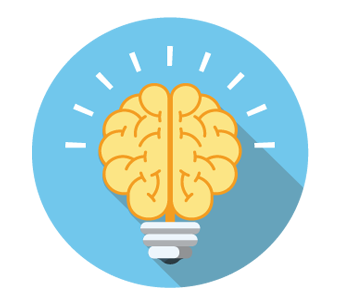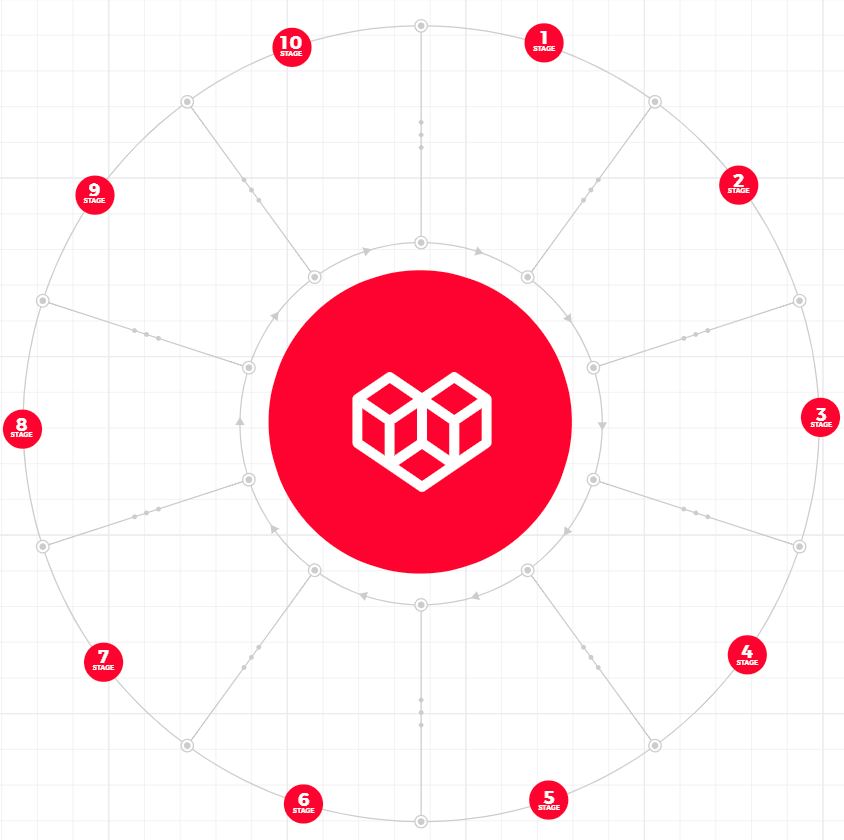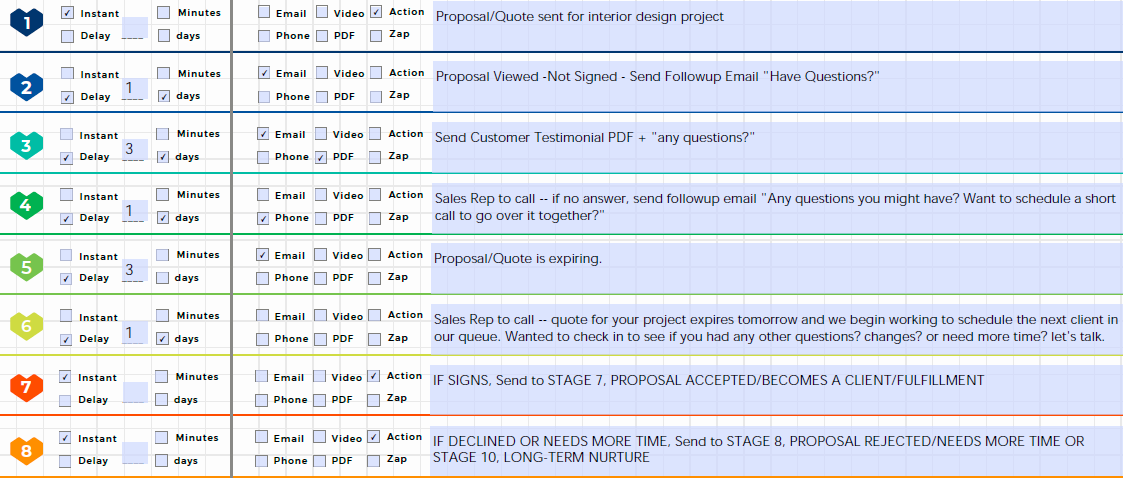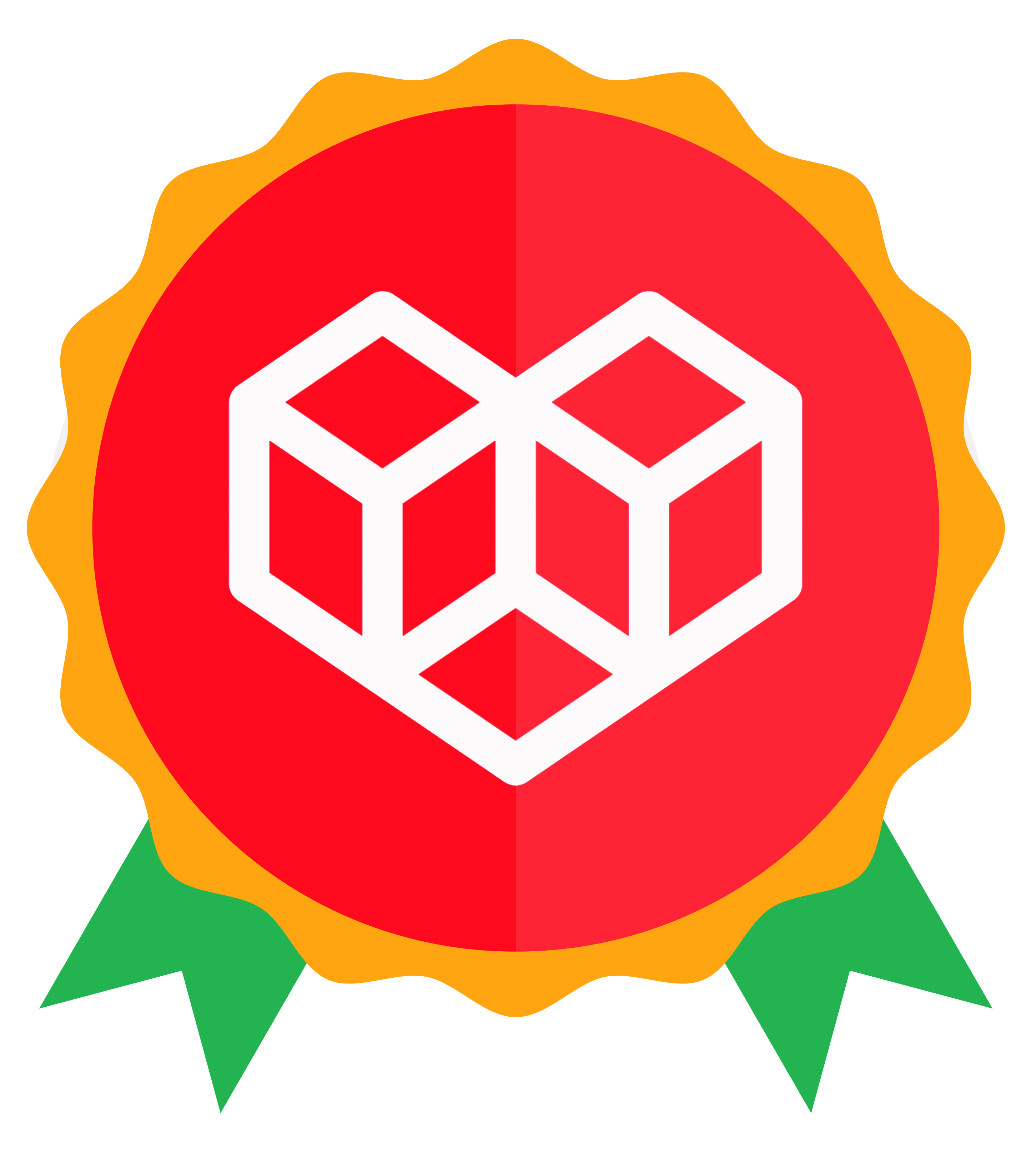We're all familiar with the Customer Journey.
Most would say there's nothing mind-blowing about the path a customer takes to purchase...
I would beg to differ.
For years, the customer journey from prospect to customer/raving fan has been understood and conceptualized as a funnel focusing on just 3 stages:
1) Top of Funnel (Awareness)
2) Middle of Funnel (Consideration)
3) Bottom of Funnel (Decision)
Simple, straightforward, clean -- a linear journey based off an expected path that your ideal customer would take on their way to purchase.
It's too bad that real life -- and real customer journeys -- are not so simple, straightforward, and clean.
They used to be, which is why this approach used to work.
So, what changed?
Consumers stopped following a linear path.
And, what is this new path?
In today's training, I'm going to share exactly that.
As an award-winning Marketing Consultant and CEO of the digital marketing agency, Built by Love®, I've spent the last two decades on the front lines of the customer journey. I've thoroughly researched how today's prospects really move, in real time, in real life. What I found resulted in me developing a powerful, proprietary process called the Marketing RAMP®.
The RAMP® (Responsive Automated Master Plan) gives business owners a truly complete marketing strategy, based on real-life customer journeys, which is further broken down into roughly 10 stages. As you can imagine, this level of detail is vital in creating a buying experience that drives sales again and again.
We don't have enough space in this article to take you through the entire Marketing RAMP® process, but I will show you how to harness the power of the customer journey so you can start implementing it into your business right now for scalable success. (And if you want me to take you through the entire RAMP® process, click here to schedule a free consult with me to get started!).
Here’s what you'll be learning in today's training:
Everything I'm about to share here are strategies you can immediately implement. They are tried and true processes that my team and I use with my own agency as well as the clients we serve.
That being said, you might want to download the PDF guide so you have it to reference anytime as you implement what you learn today. It's free and it will provide you with everything you’ll need to get started.
Claim Your FREE How-To Guide Now
Transform the Customer Journey Into a Scalable Buying Experience
How the Customer Journey has Changed (and why it's Vital to Success)
Before I show you how to map your real-life customer journey, we first need to understand how their behavior has changed and why.
This isn't just a history lesson for history's sake. If you understand WHY this new approach works, you'll be better equipped to make adjustments to best fit your needs. You know the adage, "Give a man a fish and he eats for a day, teach a man to fish and eats for a lifetime?" Well, right now, we're going fishing...
Consumers have stopped taking the linear path to purchase for a number of reasons, but primarily it's because their choices and options have exploded.
Not only are their TONS of options, competitors' ads are served up around every turn, and instant answers (and delivery!) are available with a tap on the screen.
Today's real-life, real-time path to purchase is cyclical.
Shoppers are in the driver's seat of a 4x4 and they take that sucker everywhere! They jump forward and back and move up and down in the path to purchase. It is a back-and-forth wave of product and brand research, site visits, social opinion, and value alignment.
At this point, you might be thinking: "Well, as long as the funnel approach eventually gets them to where I want them to go isn't that a "good enough" customer journey?"
My answer is: "Sure, if you're okay with losing money and letting prime leads slip through the cracks, then the funnel is a "good enough" customer journey."
The problem is, the funnel approach doesn't only let prime leads slip through the cracks...it can also drive customers away.
Because the linear funnel doesn't take into account where your prospects and customers are in their "real-life" customer journey, they will often receive marketing and sales offers that are out of sync with their current mindset. This creates mental friction, and you can bet that you'll lose the sale.
Time for a hard truth:
If you don't adjust the way you market and sell according to these new patterns, your business will not survive.
How to Map Your Prospect's Real-Life Customer Journey
All right, now that you know why the non-linear customer journey is critical to success...how do you go about mapping it?
This brings us back to the Marketing RAMP®. As mentioned earlier, this is a complete marketing blueprint with a methodology that focuses on engagement and, most importantly, enabling customers to move in and out of stages dynamically.
The Marketing RAMP® proprietary process includes 7 steps in total, but to keep this training laser-focused, I'm just going to take you through the 4th step here, which is "Map the Customer Journey."
And of course, if you're interested to learn more about the Marketing RAMP® or have us do all the work for you, schedule a call with me or my team to get started.
Below, I am going to list an example set of 10 Stages that could apply to most paths to purchase. Your specific business may have slightly different stages and actions that happen, but hopefully this example will make it clear HOW mapping the customer journey with dynamic stages works.
Use the example below to help you determine how you will define each of the stages in your customer journey.
Above is what we call the "high-level view." I'll explain what each of these stages means below (remember, yours will be unique to your business).
STAGE 2 | SEGMENTATION/QUALIFICATION
Your second stage might be a qualifying stage to see if you can actually do business with this prospect. This may be something like a quiz to see what their primary pain point is, or another qualifier like their geographic area.
For example, if you own an interior design firm, you might ask what kind of space the prospect is looking to redesign -- Their business? Their bedroom? Their summer home? Depending on their answers (or lack of answers) to these qualifying or segmentation questions you can automatically send them relevant information, an offer for a free consult, or send them to a different stage altogether (such as STAGE 9: DISQUALIFIED).
STAGE 3 | ALIGNMENT/INDOCTRINATION
The alignment/indoctrination stage is much like dating...you're getting to know each other, you're learning about each other's values, and seeing if you want to continue seeing each other. Customer alignment means your prospect perceives that your brand's values are on the same track as theirs, and because of such, they're more than happy to do business with you. I talk in depth about alignment and indoctrination emails in my previous blog post "Why Love Should be at the Center of Your Marketing Strategy." Click here to read.
During this stage, you may also be gently asking for them to take an action you wish them to take at the beginning of the sales process (such as scheduling a consult) as seen in this example.
STAGE 4 | TRUST-BUILDING/RAPPORT
If your prospect doesn't schedule a consult or take another action within Stage 3, you could automatically move them into Stage 4: TRUST-BUILDING/RAPPORT.
This stage will continue with customer alignment, but just like a relationship will focus on building trust and rapport. This is essentially providing non-invasive, nurturing, and value-added emails with very few (if any) hard CTAs. They could be a combination of inviting the prospect to link up with you on social media or sharing tips, advice, inspiration, or info that gives them value, free of charge.
STAGE 5 | SCHEDULED A CALL
Say your prospect does take action during STAGE 3 ALIGNMENT/INDOC or STAGE 4 TRUST-BUILDING/RAPPORT, and they've "scheduled a consult." If so, they would automatically move into this stage which could include email or text reminders about the upcoming consult and any other information they may need.
STAGE 6 | PROPOSAL STAGE
Your sixth stage could be the next step in the relationship, which would be the receipt, review, and consideration of a proposal. This might also be the "decision stage" where they choose to buy or don't buy.
This stage could include timed emails or texts that offer to answer any questions, or supply further testimonials about "what to expect" if they do business with you.
Keep in mind, one could skip directly from Stage 1: NEW LEAD to Stage 6: PROPOSAL/DECISION STAGE.
STAGE 8 | PROPOSAL REJECTED/NEEDS MORE TIME/DISQUALIFIED
Say your prospect doesn't sign your proposal, or buy your product/service. Perhaps they need more time to decide, or they're waiting for funding, or whatever the reason is, they're not ready to do business with you. Your Stage 8 can address the needs of customers in this stage.
For example, if they "need more time," you could have a bi-weekly or monthly reminder for your sales rep to call or email. Or, continuing on with the interior design firm example, say they're looking for commercial work and you only do residential. While they wouldn't qualify to go into the Proposal Stage, you may want to have something set up where you refer them to a colleague or check back in with them 6 months later.
Regardless of what your Stage 8 is, most businesses would benefit from having a stage in their customer journey that nurtures the ones that need more time.
STAGE 9 | TESTIMONIAL REQUEST
Your ninth stage could be following up with happy customers to request either a testimonial or referral (or both!) This stage can be quite dynamic, using NPS surveys to first see how they feel about your product/service, and then if they answer within a certain range, different actions can happen.
For example, if you offer a scale of 1 to 5, with 1 being UNHAPPY and 5 being VERY HAPPY, and you have a customer who answers with a 4 or a 5, it's pretty safe to ask them for a testimonial or referral of your company to their friends and peers. Alternatively, if they answer 1 or 2, you can have this trigger someone from your team to follow-up with a phone call or email to fix any issues.
STAGE 10 | LONG-TERM NURTURE
When there's nowhere else for a prospect or existing customer to go, they get dumped into the final stage, which should be something like "long term nurture." This should be an infinite stage that is very low touch, but still delivers value. If you have a regular monthly or weekly blog, or podcast, you have all the material you need for a stout long-term nurture campaign, as you can just deliver one a week and continue to add to it.
This keeps you in the prospect's world, and better yet, you're hopefully delivering interesting, valuable content for FREE and not asking for too much. They'll remember this and when it's time for them to make a purchase decision, you will remain top-of-mind.
Now that you have an idea of what the stages would look like for a dynamic, non-linear customer journey, you can see why this approach is so powerful.
Instead of letting your customers and prospects get stuck in the "wrong" funnel or simply fall away into no-man's-land, you can maintain momentum and continue driving value, trust, and alignment so you can close more sales and grow your business.
One of the BEST things you'll get from a Customer Journey mapped the Marketing RAMP® way (aside from more sales!) is laser-sharp reporting.
You'll be able to clearly identify:
- How many people are in each stage at any given point in time.
- Which stages are performing well and which stages under-perform.
- The true path to purchase! You'll be able to see if some prospects skip steps and jump right to purchase. You can use that info to tweak a particular stage to add in an offer or incentive to purchase.
Hopefully you've downloaded your free how-to guide already. If not, you'll want to make sure to do that now. Trust me, you'll want this resource in your pocket as you bring your marketing strategy up to speed!
Claim Your FREE How-To Guide Now
Transform the Customer Journey Into a Scalable Buying Experience
How to Harness the Customer Journey to Drive Sales & Scalable Success
I hope you can see how mapping the customer journey in stages like we did above will help you deliver messaging and offers at the right time.
But how long should each person "live" in each stage? What if they're asleep at the wheel or non-responsive? How many messages should we send before we give up altogether?
To answer those questions, we're going to dive into Ideal Duration, Max Duration, and Cadence.
Ideal Duration
Ideal Duration is the ideal time it will take a person to enter the stage and then exit the stage. Ideally, they would be exiting the stage by taking an action. If they do not, you should automatically move them into the next "appropriate" stage, such as rapport-building, disqualified, or long-term nature.
Each company has a different Ideal Duration for each stage. There is no hard and fast rule for this number, it must reflect what works for you.
Max Duration
Max Duration is the maximum time someone should spend in each stage. And just like Ideal Duration, every business will have a different "max duration" number. (Remember, if you need help with this, schedule a free consult with me to help figure it out. My team can even walk through the entire RAMP® with you).
After the ideal duration has ended there is usually some time before Max Duration where you can deliver more value and touchpoints up until you hit Max Duration. The items you deliver in between Ideal and Max Duration can be pieces of content and assets that are still valuable but not as valuable as the ones you included in Ideal Duration timespan.
This is because once the prospect has passed the Ideal Duration window, you can safely assume the probability of purchase for this prospect has diminished.
But once they hit "max duration" you should automatically move the prospect out of the stage.
You do this because it doesn't make sense to bombard them with communications/offers/or requests forever. If you do, most likely you'd get moved to unsubscribe or identified as "spam."
Again, we are meeting the prospect where they are on their path to purchase, NOT forcing them onto our path.
Cadence
Cadence is the timing of each communication, for example, one email once a week. In most things in life, timing is everything, especially when it comes to sales. In addition to figuring out the touchpoint cadence, you'll need to identify what types of messaging they will get.
Types of messaging can be anything from text messages to phone calls to direct mail to emails. They can contain videos, special offers, a question or quiz, or any number of things. It's always best to mix it up and never send two emails in a row making an ask (unless, of course, you're doing a flash sale!)
Let's use STAGE 6: PROPOSAL from above as an example.
Say you own an interior design firm, and you send a potential client a quote or proposal for work. You might have a certain length of time before this proposal expires that looks something like this:
- Ideal Duration is 5 days
- Max Duration is 10 days
And during this window of time where decision is pending, you know the things that are important to them at this stage are:
- Cost and payment options -- What are they really getting for their money?
- Pictures of work and reputation -- What are examples past work? What are certifications or awards you hold? How are you connected to other organizations?
- What is the process like to work with you? -- Customer testimonials and success stories are great here!
So, with all of that in mind, your STAGE 6: PROPOSAL SENT messaging cadence might look something like the image below.
Looking at the two white columns on the left-hand side, pay attention to the number of days between each communication (listed in the left-most column) as well as the type of message or action (seen checked off in the right column). The text in the blue boxes on the right describe what happens at this point in time.
And with that, we've officially created one complete customer journey stage!
Can you imagine the power behind this when Stages 1-10 are completed and up-and-running?
Let's recap on some of the most important details about transforming the customer journey into a scalable buying experience.
The Marketing RAMP® Customer Journey Recap
- The Marketing RAMP® Customer Journey consists of several stages (or micro-funnels). Rather than one big funnel where you keep trying to push a general offer down a linear path, you design smaller funnels that are highly targeted to deliver specific value based on where they are in your world.
- The Marketing RAMP® Customer Journey is dynamic because our customers and prospects are dynamic! They may enter, exit, and re-enter stages multiple times. The path to purchase is not a straight, clean line and our marketing is designed to reflect current buying behaviors.
- Each stage should deliver the most important value during the most critical times in each stage which is based on the Ideal Duration. And because we know both our Ideal and Max Duration as well as what the prospect or customer will need at each stage, we can identify what assets are needed and how those assets should be delivered.
- Max Duration is when you automatically move the prospect out of the stage. You do this because it doesn't make sense to bombard them with communications/offers/or requests forever. If you do, most likely you'd get moved to unsubscribe or identified as "spam."
- Cadence is also important, as it determines the timing of each communication, so you send touchpoints often enough, but not too often.
A Marketing RAMP® is not a small undertaking. It requires a lot of work, clear strategy, and a team of professionals who can deliver powerful copy, assets, stage cadences, and relevant offers.
If you'd like help tackling this task for the highest chances of success, I'd like to invite you to schedule your free strategic consult and talk with someone from my team to see how we can help. We can just help you map your customer journey or we can design the complete Marketing RAMP® for you, including writing the copy and building the automation!
Before you go, don't forget to get free access to your Mapping the Customer Journey Guide below.
Claim Your FREE How-To Guide Now
Transform the Customer Journey Into a Scalable Buying Experience































